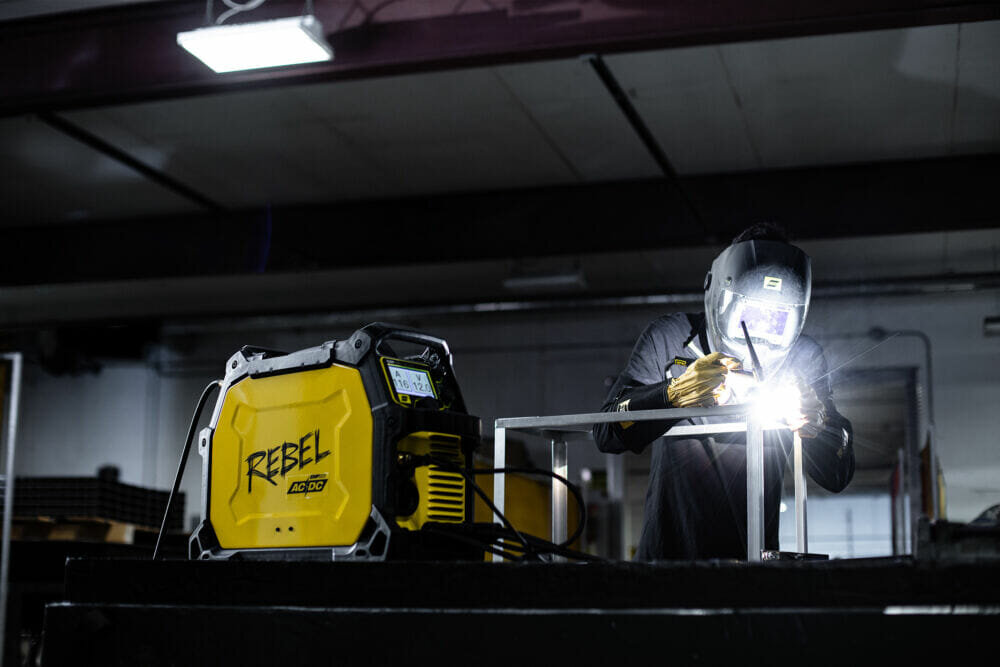ESAB has introduced Rebel™ EMP 205ic AC/DC, the world’s first true all-process, portable, inverter-based welding system. Rebel EMP 205ic AC/DC enables users to TIG weld with AC and DC outputs, use high frequency (HF) for non-contact TIG arc starts, MIG weld with solid wires (steel, stainless or aluminium), flux cored weld with gas-shielded and self-shielded wires and Stick weld.
When designing this unit, ESAB added AC TIG capabilities while maintaining all the benefits users expect from Rebel multiprocess welders. These include sMIG (“smart MIG”) technology, input voltage flexibility, a compact footprint, portability (the unit weighs 25.5 kg), five-handle lift points, colour TFT LCD operator interface and a rugged steel housing. ESAB added a dual solenoid valves so operators can utilise various gas cylinders simultaneously connected to the machine; they can move between TIG and MIG/MAG functions with ease and without the need to remove torches or disconnect gas lines.
Operators can weld material up to 6 mm thick in a single pass and enjoy excellent arc stability throughout the entire output range. The unit has a maximum output of 235 amps/26 volts for MIG/flux cored welding, 180 amps/27.2 volts for Stick welding and 205 amps/18.2 volts for TIG welding. View product video.
“ESAB has redefined the multi-process welder,” says Dane Windsor, Global Product Manager – Light Industrial Products. “Other brands of multi-process units will not combine AC TIG and MIG in the same power source, or they will sacrifice arc performance in one or more processes to gain the convenience of multi-process. The unique Rebel 205 AC/DC delivers premium performance in all processes, conveniently packed in a single machine.”
Windsor notes that during ESAB’s voice-of-customer research, users were adamant that they did not want to gain AC TIG capabilities if it meant compromising arc performance.
“Users wanted us to add full TIG-AC functionality in the same Rebel packaging, and we delivered,” says Windsor. He notes that other multiprocess welders sacrifice performance in one or more processes, especially with cellulosic MMA electrodes. ESAB encourages side-by-side weld test comparisons and believes that the Rebel will provide a superior experience for welders of all skill levels.
Input Voltage Tolerance
Rebel 205ic AC/DC functions flawlessly on any input power voltage throughout its entire 90V to 270V input power range. When connecting to generator power, use a generator with an output greater than 7 kVA.
“Rebel 205ic users want to go anywhere and weld anything,” says Windsor. “Multi-voltage input power provides location flexibility. Rebel 205ic offers the convenience of 120V power plus the ability to step up to 230V power for welding thicker material or using a larger diameter electrode.”
Windsor also notes that Rebel 205ic tolerates input voltage fluctuations better than any other welder in its class. Even in “dirty power” situations or when another load suddenly comes on-line (such as a grinder or compressor), Rebel 205ic can keep the welding output consistent.
Full-featured TIG Controls
Rebel 205ic AC/DC helps operators achieve better results by providing the type of advanced TIG controls found on industrial units. Through its colour TFT LCD interface, operators can adjust:
- AC wave balance control from 60 – 90 percent electrode negative (EN). More EN improves penetration, while reducing EN adds more “cleaning action” that removes aluminum oxide.
- AC frequency control adjustable from 25 – 400 Hz. Higher frequencies produce a narrower, more intense arc cone that helps direct the arc at the root of the joint in a fillet weld. They also narrow bead width and increase penetration and travel speeds.
- Pulsed DC TIG with outputs between 0.1 and 500 Hz. Stainless steel fabricators and those working with thin metals or other heat-sensitive applications use pulsed DC TIG to control heat input, narrow the weld bead profile and increase travel speed. A slow frequency, such as 1 Hz, acts as a metronome so that welders can establish a good cadence for adding filler rod.
- Amplitude offset. Adjust either EN or EP amperage to control the energy into the work piece as well as cleaning action. Adjusting EN will direct more energy into the work piece and remove heat from the tungsten to create a smaller bead profile, improve penetration and reduce preheat on thicker material while using a smaller tungsten. Increasing EP will allow additional cleaning action while maintaining a certain level of energy directed into the work piece.
- HF (High Frequency) arc starts eliminate the need to touch the tungsten to the workpiece. Use HF TIG for applications for convenience or applications requiring non-contact arc starts. Rebel also provides for positive arc starts without HF using its Lift TIG mode.
- Upslope (ramping up current) to prevent excessive heat input during arc start and downslope to taper current at the end of a weld to help prevent crater cracking.
Basic and Advanced Functions
The Rebel has two operating modes, Basic and Advanced, that make welding easy for beginners or lets those with more experience fine tune parameters. Operators interact with the Rebel through the 109 mm colour display, using the same thin-film transistor (TFT) LCD technology found in tablets and smart devices for the brightest clarity. No other welder combines this level of simplicity, performance and control.
Rebel’s control display incorporates a built-in user manual with graphics and text to help with weld process set up, such as for connecting the work and ground leads to the correct terminals, as well as for ordering parts. The display lets users select the welding mode, as well as set and control all functions.
Smart MIG Advantage
With the Rebel’s sMIG (“smart MIG”) function, users begin MIG welding by setting metal thickness and selecting wire diameter. The Rebel will automatically adapt to any popular steel, stainless, chrome-moly or aluminum filler metal/gas combination and provide a stable MIG arc. The sMIG mode enables users to weld thicker or thinner metal by increasing or decreasing wire feed speed, as well as to raise or flatten the bead profile by increasing or decreasing voltage. Welders can also adjust inductance to fine tune arc stability and control spatter. As users adjust one parameter, sMIG automatically adjusts others to keep the MIG arc stable.
Using an exclusive, built-in algorithm, sMIG monitors the operator’s technique and continuously adapts the MIG output to provide a stable arc and superior, repeatable welds.
“sMIG takes smart to a level never-before-seen in the industry,” says Windsor. “Experienced welders become productive more quickly, and novice welders start producing quality welds in less time. The sMIG feature takes away the doubt of welding with incorrect settings and so users can focus on good gun technique. Rebel gives users confidence to weld anywhere with a ready-to-weld package.”
For those welders who prefer traditional MIG and flux cored welding, the Rebel enables users to pre-set and adjust wire feed speed and voltage, as well as set run-in speed, adjust burn-back control and program timers for spot and stitch welding. When welding, the control shifts to display amperage and voltage.
ESAB Welding & Cutting Products is a recognised leader in the welding and cutting industry. From time-honored processes in welding and cutting to revolutionary technologies in mechanized cutting and automation, ESAB’s filler metals, equipment, and accessories bring solutions to customers around the globe. For more information, visit www.esab.com.





